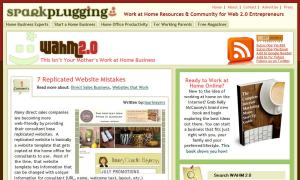 One of the biggest concerns I hear from direct sellers when they contemplate blogging is the fear of what to write about. “How will I think up new stuff to write all the time?” “I’m not an expert on anything!” As a result, they paralyze themselves into complete inaction.
One of the biggest concerns I hear from direct sellers when they contemplate blogging is the fear of what to write about. “How will I think up new stuff to write all the time?” “I’m not an expert on anything!” As a result, they paralyze themselves into complete inaction.
But here’s a news flash. Your blog doesn’t HAVE to be a great work of literature (in fact it shouldn’t be!) And it doesn’t have to be the length of War & Peace either (and it shouldn’t be!) Here’s a little test. Get out a pen right now, and come up with 3 things your customer can do right now to solve a problem he/she has. Now this should not involve BUYING anything. Instead, if you sell kitchen products, it might be 1) Plan weekly menus, 2) Prep veggies ahead of time, and 3) Stock up on staples. Quick and easy, right? And that’s the foundation of a blog post…3 quick and easy ways to save yourself headaches at dinnertime.
Don’t let your need to be perfect or your fear of not having all the answers keep you from writing the blog that will help you make more money! Just get out there, share little tips, and make the world a little better for someone. After all, someone NEEDS your content right now! You are solving PROBLEMS, after all. Don’t keep it to yourself! Get out there and start blogging! You’ll be glad you did.
And if you’re ready to start blogging for your direct sales business, you may be interested in my new course, Blogging for Direct Sellers. You can get all the details by clicking here.
What do you think? How have you overcome your fear and gotten started blogging? Would love to read your comments below!
 Social media activities for direct sellers are primarily focused around two activities: relationship development and list building. Through a content-marketing strategy, a direct seller provides free, actionable content that prospects can use right now without spending a dime. After that, the direct seller builds relationships with prospects through social networking tools, and invites those prospects to consume her content. If the prospect finds value in the content, that prospect may subscribe, and at that point, the list begins to be built. You ONLY have permission to market to that prospect once they have opted in to your list.
Social media activities for direct sellers are primarily focused around two activities: relationship development and list building. Through a content-marketing strategy, a direct seller provides free, actionable content that prospects can use right now without spending a dime. After that, the direct seller builds relationships with prospects through social networking tools, and invites those prospects to consume her content. If the prospect finds value in the content, that prospect may subscribe, and at that point, the list begins to be built. You ONLY have permission to market to that prospect once they have opted in to your list.
 It’s pretty easy to design a blog to find new customers for your business. Simply identify the problems your customers have (related to your product line), and then provide simple, actionable solutions that your prospects can use right now without spending a dime. As your readers come to know, like, and trust you, they may become customers for your business.
It’s pretty easy to design a blog to find new customers for your business. Simply identify the problems your customers have (related to your product line), and then provide simple, actionable solutions that your prospects can use right now without spending a dime. As your readers come to know, like, and trust you, they may become customers for your business. I love analytics. I really do. In fact, I’ll go so far as to say I’m an analytics junkie. Why? Because analytics are validation. They show how your social media efforts are paying off, and what you should be spending your time on. It’s the hard data that you can use to find out if what you’ve done is bringing you the traffic that can make you money, or if it’s a complete waste of time.
I love analytics. I really do. In fact, I’ll go so far as to say I’m an analytics junkie. Why? Because analytics are validation. They show how your social media efforts are paying off, and what you should be spending your time on. It’s the hard data that you can use to find out if what you’ve done is bringing you the traffic that can make you money, or if it’s a complete waste of time.
 As a direct sales executive or salesperson, it is important to read and comment on other blogs targeted at your niche. I’m often asked why this is. There are several reasons why this approach can be beneficial for your business.
As a direct sales executive or salesperson, it is important to read and comment on other blogs targeted at your niche. I’m often asked why this is. There are several reasons why this approach can be beneficial for your business.


